Top>HAKUMON Chuo [2014 Spring Issue]>[Developing Global Human Resources] Practical English Conversation Skills
 Index
Index
Developing Global Human Resources
Practical English Conversation Skills
Guiding tourists on the spot
Chuo University English Speaking Society (ESS)
One activity of Chuo University English Speaking Society (ESS) is guiding tourists. At sightseeing spots such as Meiji Shrine, the East Gardens of the Imperial Palace, Asakusa in Tokyo, and Kamakura city in Kanagawa Prefecture, the members approach foreign tourists and offer to guide them without an appointment.
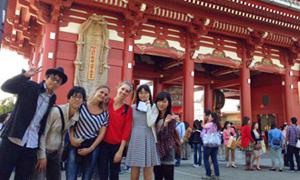
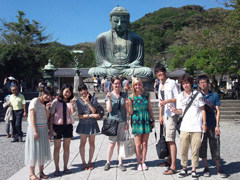
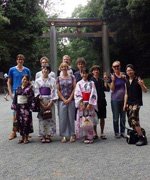
Meiji Shrine
Fifteen Chuo ESS members organized in four groups stood in front of the main gate of the East Gardens of the Imperial Palace and attentively watched the foreign tourists.
The area around the Imperial Palace is regarded as a sanctuary for marathon runners, where many runners of all ages, male and female, passed by. There was even a runner in a panda costume.
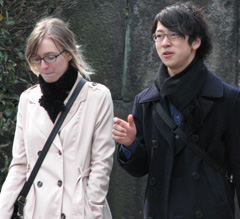
Guiding tourists from Australia at the East Gardens of the Imperial Palace
Group 1 composed of four members spoke to three foreign tourists, two of whom were younger and one of whom seemed to be their mother’s age.
The tourists were surprised by the students who suddenly approached them, but smiled after they understood their intention.
When the tourists agreed to go sightseeing together, the world had changed dramatically in a few minutes.
ESS names the above process “approach.”
The members are required to confirm with the foreign tourists the following points when they approach them: (1) whether or not the tourists are English speakers; (2) that the members are university students learning English; (3) that they are offering to guide the tourists; (4) that their purpose is to improve their English skills and enjoy communication; and (5) that they charge no fees.
In English, they would say, “Excuse me. Do you speak English? We are college students learning English. We would like to guide you around here to improve our English skills and enjoy talking with you. Of course it’s free of charge. Can we join you?”
(Cited from ESS information material)
Self-introduction
Okuto Suzuki, a 3rd year student in the Faculty of Economics and the chairperson of ESS, introduced himself as they walked. He made his name easier to remember by associating it with “October.” The students learned that the tourists were from Australia.
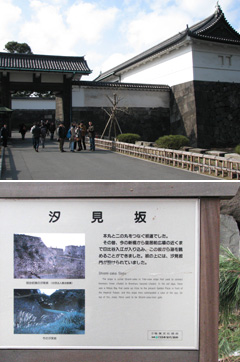
Both pictures at the East Gardens of the Imperial Palace
After getting their tickets at the management office, they went straight, seeing the Museum of the Imperial Collections on the right hand. Ahead on the right, they saw the first featured spot called Doshinbansho, from which guardians used to monitor the retinue of feudal loads for protecting Edo Castle. Simply put, it was a guardhouse.
The pathway was made as a winding slope, “so enemy horses slowed down,” the members explained. The three women seemed convinced.
They saw Hyakuninbansho on the left and Obansho on the opposite side. After passing over the Fujimi-yagura Keep and entering the Honmaru-hiroba Park through the remains of the Chujakumon Gate, the panoramic view of a lawn garden came into sight.
Since the featured spots are distanced from each other in the East Gardens, the ESS members needed to talk about something other than sightseeing. This was a great opportunity for practicing free conversation.
The students tried to find various topics including the nationality of the tourists, where they came from, how long they would stay in Japan, and what brought them here.
“I was so lucky, because they were Australian. I asked which city they lived in, and they answered Brisbane. I actually did a homestay there when I was in grade nine,” says Mao Komiya, a 2nd year student in the Faculty of Law. When they got excited chatting about foods and sightseeing spots in Australia, the Australians could not help speaking faster. “Sometimes I couldn’t understand what the native speakers said and had to ask them to speak more slowly,” says Komiya.
“Once I communicated using gestures with a German couple who didn’t speak English,” says Suzuki, the chair of the club. “What’s important is the willingness to communicate by any means. That is the pleasure of guiding,” says Kentaro Wada, a 3rd year student in the Faculty of Economics and the chief of the Guide section.
For Komiya and her group member Momoka Usuyama, a 2nd year student in the Faculty of Commerce, this was the sixth experience guiding since entering the university. “We never have any kind of rehearsal. If we don’t break the ice, our conversation doesn’t go far,” says Usuyama. “In early days, I hid behind the older students,” confesses Komiya.
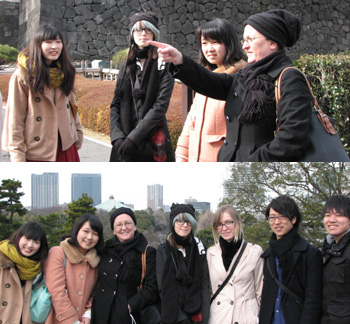
Smiling members with three tourists from Australia at the East Gardens.
They climbed Tenshudai, the remains of the main keep, with the three Australian visitors. The keep of Edo Castle is said to have been 58 meters high and conspicuous, but today its ruins look like a hill. From there, they saw the roof and golden symbol of Nippon Budokan surrounded by many high-rise buildings.
“The Budokan was a venue for judo in the 1964 Olympics in Tokyo. The Beatles performed there in 1966.” Some of the visitors nodded, while others were indifferent. According to the members, different generations respond to their explanation differently.
There, they took pictures of one another with their own camera or smart phone. This made them more relaxed and friendly, as if they had been friends for a long time.
Seeing a music hall called Tokagakudo and the Music Department of the Imperial Household Agency on the left hand, they reached Shiomizaka, or the Ocean Viewing Slope. In the Edo Period, people could see the sea from this slope. This is a popular spot as you can easily compare the past and the present through photos.
After the Prefectural Tree Emblems and the Suwano-chaya Tea House, they came to the Ninomaru Garden. Komiya says,“International visitors tend to walk slowly in a garden or around a pond. Probably they think this is a part of Japanese culture.”
To explain things unique to Japan in English requires preparation in advance. After returning the same path with the Australians, they finished the roughly hour-long guiding at the exit.
They said thank you to each other, and some exchanged their Facebook information before saying good-bye.
The ESS members repeat this one-hour guiding two or three times a day. “When we talk about what we study on a daily basis, we enjoy the conversation more,” says Kahori Tsuchida, a 3rd year student in the Faculty of Letters and the sub-chief of the Guide section. “I’m good at talking freely,” says Yuuki Imamizu, a 3rd year student in the Faculty of Law. “If a tourist comes from a place I am familiar with, I will talk about it. If a tourist came from the United Kingdom, for example, I would say, “Harry Potter is amazing.”
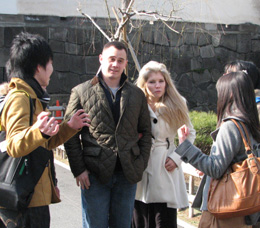
A couple from Kentucky. Members were relieved that the couple’s English was easy to understand.
Chief Wada talked about his unique experience. When he began talking to a French lady about World Cup football, he was surprised by her response.
“I mentioned it casually because I simply thought people were looking forward to it, but she said,‘TV has nothing on but football and my favorite programs are cancelled. The street is noisy. I really hate World Cup football.’”
The world is larger than we thought.
Different members have different experiences.
One member says, “When I spoke to a person in English, that person answered in Spanish,” while another says, “At an entrance, a businessman told us that he came to the place frequently.” Yet another reveals, “Couples tend to frown, probably because they don’t want to be disturbed.”
Nevertheless, they approach the foreign tourists over and over without giving up. Their experiences will certainly be helpful in the future.
Even if they hesitate in taking the first step, their English skills improve gradually, and they acquire the communication skills of talking even with strangers. They also understand Japanese culture more deeply as they try to explain in English.
Through these activities, they find themselves becoming more proactive. ESS guiding is, in a way, a curriculum for enhancing their personal ability.
A couple from Kentucky, U.S.A.
Group 2 met a young couple from Kentucky, in the U.S. “Their pronunciation was clear, so we could understand them easily. They also cared about our response and tried to continue the conversation with us,” says Yukina Haraguchi, a 3rd year student in the Faculty of Law and the liaison of the Guide section, mentioning their favorable impression. “But it was difficult to adjust the depth of our conversation, because the woman’s job was related to politics and political parties.”
British, then Colombian
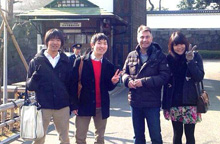
With a British sightseer
Natsuki Yamamoto, a 3rd year student in the Faculty of Letters, was in Group 3, which met a British person, and then a Colombian tourist. In both cases, they approached the person walking alone. “We enjoyed talking about the 2014 Olympics in Sochi.” This topic was timely, as they guided those tourists during the Winter Olympics. They were also excited by the encounter. “I plan to study British literature in a seminar. I am interested in Britain, and learned many things from the British tourist.”
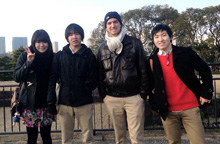
With a Colombian tourist
Mayu Fukuda, a 2nd year student in the Faculty of Commerce and a member of the same group, says with a smile, “the British person worked for a securities company in Japan, and when I told him that I am a student in the Faculty of Commerce, he talked us about related topics. His son is a university student, and he also mentioned universities in Britain.” On the other hand, “The Colombian tourist’s English had an accent which was difficult for us to understand.” She also regrets that because her understanding of the Imperial Palace was insufficient, she couldn’t explain it smoothly.
(Pictures taken by Natsuki Yamamoto, Mayu Fukuda, Momoka Usuyama and other members of ESS)
CHUO ESS ARCHIVE
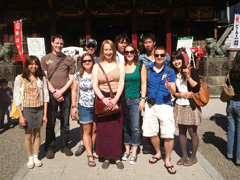
ASAKUSA
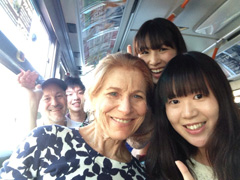
KAMAKURA
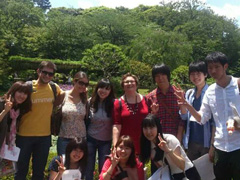
PALACE
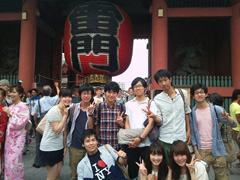
ASAKUSA
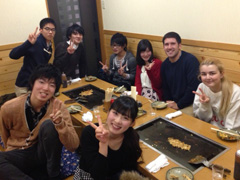
OKONOMIYAKI
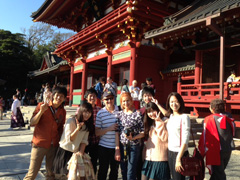
KAMAKURA
- Research Activities as a Member of Research Fellowship for Young Scientists (DC1), Japan Society for the Promotion of Science (JSPS) Shuma Tsurumi
- Important Factors for Innovation in Payment Services Nobuhiko Sugiura
- Beyond the Concepts of Fellow Citizens and Foreigners— To Achieve SDGs Goal 10 “Reduce Inequality Within and Among Countries” Rika Lee
- Diary of Struggles in Cambodia Fumie Fukuoka
- How Can We Measure Learning Ability?
—Analysis of a Competency Self-Assessment Questionnaire— Yu Saito / Yoko Neha - The Making of the Movie Kirakira Megane








